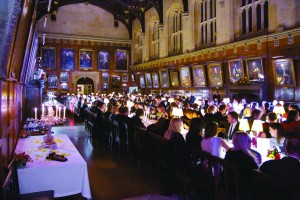
September 22, 2013, by Peter Kirwan
Dido (EDOX) @ Christ Church Banqueting Hall, Oxford
Unavoidably, Christ Church itself was a significant player. A catwalk-length thrust stage led down from high table to the centre of the hall. Lamp and firelight provided the illumination, casting the portraits of royalty and alumni in shifting shadows. The high ceiling and eye-straining distance between high table and the enormous double doors at the far end somehow, in a packed room, allowed for extraordinary acoustics, the sounds of choirboys crystal clear from even a great distance.
Framed with an introduction by Michael Dobson and a prologue by a tuxedoed Stephen Longstaffe, the play (performed primarily by current Oxford students) was explicitly presentational. A Chorus of young actors dressed in the uniforms of King Edward VI School punctuated the performances with sung Latin choruses and enacted formal dumbshows in illustrations of Aeneas’ story, keeping the visibility of the youth training culture alive, this appearing as an offering to the university from its boys.
Dido is referred to as Eliza throughout the play, and directors Elisabeth Dutton and Matthew Monaghan took the cue to emphasise the significance of the moment of original performance by dressing Alex Mills’s Dido as Elizabeth, in a surprisingly close copy of the portrait that hung behind high table. The decision felt even daring – the danger of staging the virgin queen in love, jilted and destroying herself resonated across the centuries, and Longstaffe’s epilogue making clear that Dido was not, in fact, Elizabeth felt absolutely necessary to defuse the tension created.
The translation retained moments of Latin at points of key stress or emotional excess, including the formal reception of the Trojans and their grateful praise of Dido. Yet the vernacular remained accessible at all times, taking a high register that matched the formality of the occasion while punctuating it with a rich vein of humour, particularly in Monaghan’s Cupid who blew bubbles to encourage love between his victims and in the older John Holmes and Roger Dalrymple as the gossiping Anna and Barce, lightening the tone but also emphasising the tragedy as even these figures were brought to grief.
Mills was exceptional as a Dido who dominated throughout, both in terms of her huge dress and in her regular positioning on a platform above Aeneas. Her rhetorical self-positioning softened throughout, culminating in a moving halfway image of Dido seating herself and arranging Aeneas in her lap. Her stately presence at high table throughout the banquet and her slow, formal movements throughout made more potent the awful scene of her crashing through the banquet hall in shift and with her red wig gone, vulnerable and frantic as she screamed after Aeneas.
The production adopted simple but effective spatial strategies to emphasise this shift. The Trojans entered and left via the far doors, often staying grouped among the lower tables while addressing the queen. On being welcomed both Aeneas and Cupid joined the top table, moving about the higher end of the hall and providing the amusing image of Dr Emma Smith toying with the feathered wings that Cupid accidentally thrust in her face. The centre of the hall thus became a point of conflict, where Dido’s frenzy reached its peak and where she built her pyre (making use of the banqueting hall’s own fire), but also where the Chorus performed their marking of their faces with blood.
Dido’s death was, inevitably, the production’s showpiece, with Mills gathering Aeneas’ items and arranging them on the stage. She plunged her knife into her stomach and, agonisingly, took an age to die while her servants and women gathered and the Chorus joined the stage for a lament. In a remarkable sequence, the Ghost of Sychaeus entered and enabled the death, raising Dido momentarily up before taking her spirit, leaving her to collapse back in peace. As the production closed and Anna slit her own wrists, the Ghost poured sand over the bodies, bringing the production to a solemn and formal close that was undercut, amusingly, by the irreverent epilogue drawing morals such as ‘Foreign weddings seldom end well’.
The space made sense of this pageant-like play, locating it within a ceremonial and hospitable context where the allegorical and narrative levels of the story coexisted peaceably. Arranged systematically, the rhetoric allowed for a surprising amount of emotive power, bolstered by wonderful student performers and tactful use of surprise to strip Dido even as she lost her decorum. A triumph for all involved, this was a fascinating glimpse into a performance culture that demands future explorations.

[…] Gager’s Dido was accompanied by roast belly of pork and a house red, it seemed appropriate that Marlowe’s […]
Wish I had seen everything described here. From below the salt most of the action (except some of that in the aisles) was virtually invisible, though largely audible. It took a real effort of concentration to follow what was happening, and there were some bored faces around amongst younger guests! It was obviously good – wish I had seen it! Edwards’ Boys, by the way, did better with sharing out the visibility.
Sorry to hear that was your experience Valerie – what a shame! And yes, I think the second production did seem to be using that full length of the hall more.